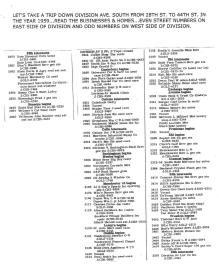
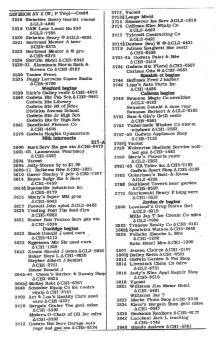
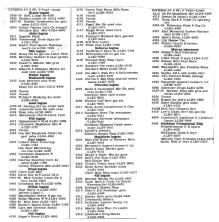

The Godwin library, shown on the home page, was built in 1937, as part of a W.P.A. project, which included the tunnel under Division Avenue at 36th Street, and the West end addition to the high school. It occupies the site of the one room brick schoolhouse, built in 1867, and razed in about 1924 when the new (as of 1924) school was built on Division Avenue. (See section "B" for other photographs and details.)
Calling the building a library has long been something of a misnomer. In the late 1930s and the 1940s the "library" consisted of the library proper, on the east side of the first floor. Marie Simpson was librarian, and Beulah Burbank was her assistant. Frank Rackett's flora and fauna museum was located in the northwest corner, and the superintendent's office in the southwest corner, first occupied by Charles Saur and his secretary, Evelyn Swanlund. Downstairs was a storage area on the south end, and the office of Marcella Houston, who did bookkeeping and bill payment.
In the 1950s and early 1960s the first floor northwest corner was the superintendent's office, and was occupied in the early 1950s by Roscoe Miner. The southwest corner might have been an office, and the east side was still the library proper. Downstairs the east side room was a teacher's lounge, the west side room was used to sell and store textbooks, and the south end room might well have still been storage. It was not normally open. In the middle 1960's the south end room was being cleaned out for some reason.
In year 2005, it's not obvious to what extent the original library building exists. It has at least been substantially modified. As of year 2005 the building is a science building.
( Some of the material provided by Lee Neugent, class of 1948. )

Up through perhaps the early 1960s there was still a concept of local communities. Local schools, local businesses, and local control. Godwin served the needs of the local community in the most basic ways. It was a rallying point for the local community, and provided a wide range of development opportunities for students. It also trained students to serve the needs of local businesses and industries. Early on the categories "commercial," "industrial arts," and "college prep" provided students with options for the direction in which they wanted to go after graduation, and training to help them succeed.
A major factor was the General Motors stamping plant on the southwest corner of 36th and Buchanan The original facility was completed in about 1936, and some still remember the drum of the pile drivers during construction. The area around 36th and the Grand Rapids and Indiana railroad tracks was originally a marsh, and that land had to be filled and stabilized. Once completed, many Godwin students obtained essentially life long employment at the plant, and often dropped out of school to get a job.
But there were hundreds of smaller businesses in the area that catered to the needs of the local community. Grocery and variety stores, bakeries, drugstores, auto sales and repair operations, clothing, feed, gas stations, which also often did repair work, jewelers, and endless small, independent restaurants and eateries of all descriptions. Most of these independent businesses are now but memories, often replaced, if at all, by chains, and few today know who actually owns a business or franchise. Names like Foster's Food Market, Hogan's Diner, and Lamoreaux's Drug store, are no longer part of the area's consciousness.
Have a glance at page 88 and page 89 from the 1950 class annual, and see how many names come to mind. Many to most of the businesses mentioned were family owned in 1950, and before, and by families who lived around Godwin, and were owned by the parents of students attending Godwin. In year 2005 few can remember the names at all, and the businesses are long gone. Stable jobs, at stable companies, are becoming a rarity in the US economy as it attempts to compete with the likes of China and India. People move around a lot, partly of necessity, partly in search of more. It is often hard for those that remember the earlier times to believe that the changes are all for the best, but then there is little choice in the matter either.
Most of the local businesses supported Godwin too, and many placed ads in the programs for school plays, and in the school annuals. These can be seen in many places on this site. Characteristic of a close knit community, people shopped, and often worked, at the local businesses, and when they graduated from Godwin, went on to continue the cycle by moving in to the community. Until perhaps the 1970s, it was common to find three generations of Godwin students. Robert A. McDonald, class of 1943, relates that his father owned a lot of the land on the south side of Godwin Avenue ( now Clements Street SE ), and at one time nine homes, starting at Division Avenue, belonged the McDonald relatives. Apparently all but the house on the east end, near Jefferson Avenue.
This section looks at the details of some of the local, typically family owned, businesses that once existed in and around Godwin. Those knowing more details about them, or others, are encouraged to come forward. Photographs are of special interest.
Lee Smith, class of 1953, has compiled a list of some of the
businesses along Division Avenue in and around 1951.
Compiled by Lee Smith, class of 1953
Norrine (Chase) Polkowski, class of 1946, has compiled a list of some of the
businesses along Division Avenue in and around 1956.
Compiled by Norrine (Chase) Polkowski, class of 1946
Left click on the images below for larger versions.

|

|

|
Left click on the images below for larger versions.
Material provided for scanning by Clarice (Wicks) Cox, class of 1953.
Above are some area businesses from 1950. In year 2008 only Engels, dating from the early 1920s, still exists.
Many of the businesses placed ads in the Godwin annuals, and in commencement and play programs over the years. Glancing at the ad pages in the annuals over the years shows a steady stream of businesses come and go over the decades. There are still many business along the same stretch of Division Avenue as of year 2005, but few of the owners will be recognizable any longer. In an era of greater mobility, some businesses are owned by people who don't live in the area, and most are franchises, whose owners are stockholders in the parent companies, Thus one is more apt to find a hamburger at McDonald's than at a Coffee Cup Restaurant.
A time honored tradition of stealing menus, a.k.a. souvenirs, has provided some examples of the fare offered at some of the restaurants and taverns once around Godwin. Where available they are included below.

Left click on the images below for larger versions.
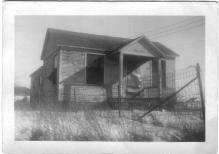
|

|
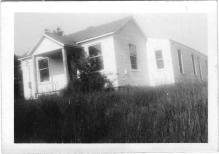
|
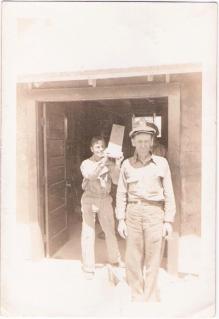
|
The photographs above were provided for scanning by Jalene Doxtator, class of 1947.
Left click on the images below for larger versions.

|
Left click on the images below for larger versions.
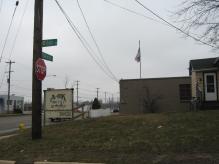
|
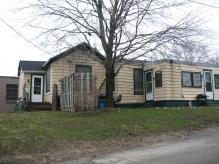
|

|
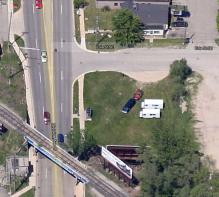
|

Left click on the images below for larger versions.
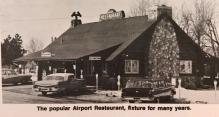
c1959 |
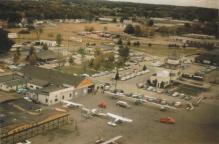
1957 |
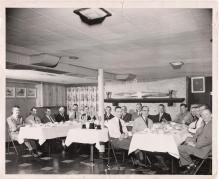
|
The photograph at the left, taken in 1957, shows the airport terminal area and surrounding buildings. In the upper left one sees a gas station one the northeast corner of Madison Avenue and 32nd Street. Below it one sees the Airport Restaurant. Once a WPA shelter, it was probably built around 1930. A large fireplace and log construction was characteristic of WPA buildings erected in parks.
The photograph above shows the basement of the Airport Restaurant, perhaps in the mid 1950s. Jalene (Doxtator) Beattie, class of 1947, says the owner was Bob Van Artsen. The restaurant was probably built in the 1930s. One of the airlines used to have their meetings in the basement part of the restaurant. The restaurant itself was a log cabin style structure. Sadly, it disappeared when the airport moved, but probably would have successful had it stayed to serve new businesses in the old airport location.
The person in the white shirt, just to the right of the pole, is Wilbert Beattie, husband of Jalene (Doxtator) Beattie, who worked for the airport for years.
See section "A" for more information about the airport in general, and the airport restaurant specifically.

Left click on the images below for larger versions.
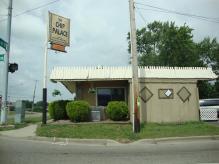
2014 |

2014 |

Left click on the image for a larger image.
An early discount store, Arlan's was located on the NW corner of Division Avenue and 34th Street, the former site of the William Godwin home. Arlans was founded in 1945, in New Bedford, MA. At it's peak in about 1965 it had 50 stores in 18 states. In 1973 it declared bankruptcy.
Left click on the images below for larger versions.
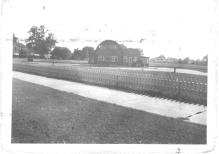
August, 1943 |

July 23, 1941 |
the area around Godwin was not highly developed yet, and Division Avenue was not a particularly busy road, and certainly not as wide as it is in year 2005. It's possible, but not easy to see in the photograph, that a barn might have existed just in the trees shown just to the left of the Bee-Hive. To the right of the Bee-Hive one can make out houses that are on what is today 34th Street. Only partially visible on the left side of the photograph, above the sidewalk, is the William Godwin house. It was used as an office for the Walbridge Trailer Park, The Walbridge family lived in the house. It burned in about 1954.
The fate of the Bee-Hive restuarant is unknown at present.


Left click on the image below for a larger version.
Shown above in a 1982 photograph, the Ben Franklin 5-10 was part of the Home Acres strip mall as far back as the early 1950s. With the demise of Engle's Jewelry in about 2010, no store dates back to the construction of the strip mall in 1927.


The image above is from page 6 of the 1946 annual.
Bertrand's is the building to the right, with the white side, on the west side of Division Avenue.
Located at 3521 Division Avenue, Bertrand's was the acme of a small family run operation. Mentor Bertrand and his wife ran the store, and lived behind it. It was typical in the early 1950s and before for a family to live above or behind their store so they could be there to tend it 16 to 18 hours a day.
Called "the penny store" by many children, all manner of teeth rotting confectioneries were sold at a glass counter devoted to items that cost a penny for the most part. It was a dentist's dream. One could buy "jaw breakers," which could of course chip a tooth or ruin a filling. Pure sugar "cigarettes," with the end died red. And many kids dreamed that an adult would actually think they were smoking. Strips of wax paper with dots of colored sugar on them. Little wax bottles of colored sugar water. Etc. Incredibly, most kids did survive those days.But millions of the adults they became have bad teeth, growing up in a day before fluoride toothpastes, and childhood's with plenty of sugar available.
The store appeared to be quite old, but Forrest Keyes, class of 1932,
believes that it dated from around 1925 or so, about the time the stretch of
Division Avenue between 28th and 68th was starting to develop.
Mentor ( also Minter, Mentor) Bertrand initially
lived in Burton Heights, and sold produce. Eventually he moved to Godwin
Heights, for reasons unknown. He was born in 1884 (1896?), and died in 1966. His wife
Edith was born in about 1895, in Minnetonka, Hennepin, Minnesota. According to the
1920 Federal Census, Minter lived in Minnetonka, Hennepin, Minnesota, in 1920, and
apparently met and married Edith at that time. This likely had to do with the job his
father, Phillip, had with the Pere Market, railroad, since in 1900 the family
lived in Moorland, Muskegon County, Michigan.
Left click on the images below for larger versions.
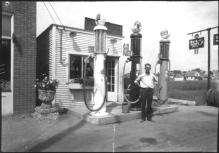
|
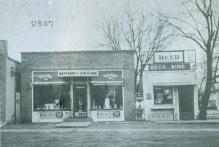
|
White Rose products were refined in various places in Canada by the Canadian Oil Refining Company. Later, the brand was apparently absorbed by Crystal Flash. White Rose symbols changed over the years, and someone might be able to get some idea how old the pumps are from the white globes at the top. The photograph was probably taken after March, 1930, when "Canadian Ethyl Gasoline" was introduced. The middle pump above is ethyl. After 1932, part of the globe was usually in red for ethyl, but of course that information is lost in the photograph above. The style of the globe is known from a dated photo to have been used as early as 1934. So the date of the photo can only be dated from about March, 1930. How long after 1934 the globe on the middle pump was used is not known for now. And there is no information as to whether any of the globes were broken and replaced. This all needs more work. Or maybe an older Godwin alumni knows more.
The pumps date from a time when motorists did not trust the gas pumps. So the station operator was required to pump the gas to the gas containers near the top of the pump, which had measuring marks. A pump handle can be seen at Darwin Peavey's left elbow. After the motorist saw how much gas was in the glass container, the station operator would let the gas drain in to the motorist's car. When they were no longer used might provide another indication of when the photo was taken.
The flowers under the window, and in the stone pot are typical of small 1930s and earlier establishments. c.f. the Twin Cabins entry below.
It's amusing that only two power wires come to the building. Whenever power was installed, apparently no ground wire was included. The third while that is now standard on all electrical connections to houses and commercial buildings.
Not easy to see, the sign above the door says "The National Refining Company Lessee." Perhaps the way of saying franchise at the time.
The pump at the left shows "Gas 14.5 cents, Tax 3 cents, Total 17.5 cents." The middle pump shows "Gas 17.5 cents, Tax 3 cents, Total 20.5 cents." The pump at the right seems to use other tenths. Best guess is "Gas 12 7/10 cents, Tax 3 4/10 cents, Total 16 /10 cents. Those prices are typical of the period around 1930. White Rose and Royal were trade names of the National Refining Company, located in Cleveland, OH. The names were introduced in 1905, and used in to the 1950s. The National Refining Company was purchased by Ashland Oil and Refining in 1950.
Notice that in the photograph below, from about 1945, showing a flooded Division Avenue. The building is no longer a gas station. One can see just how small the building was. Bertrand's is just to the south of the building.
Left click on the image below for a larger image.
The photograph above is from about 1945, and shows a flood at the corner of 35th Street and Division Avenue. In it one can see Bertrand's store, standing quite alone at the time. It's clear how many more trees were removed as more stores settled in the area.
Despite the appearance of being rather poor, Mentor's father worked for a railroad, and his brother L.D.Bertrand was apparently a doctor, living in Bay City.
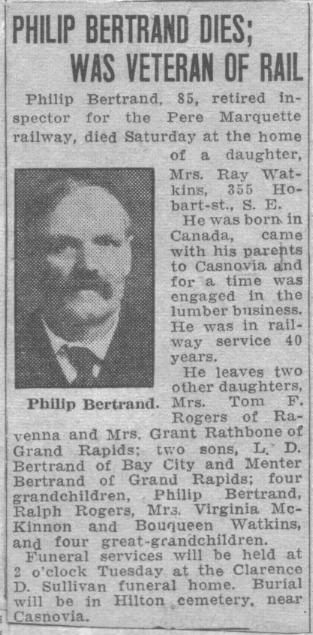
The piece above dates from about 1936.
Left click on the image below for a larger version.
Above, the house at 355 Hobart Street SE, Grand Rapids, MI, where Philip Bertrand died, in about 1936.
Minter Bertrand died in 1966. Edith died in October, 1982. The store and the building are now gone.

Left click on the images below for larger versions.

|
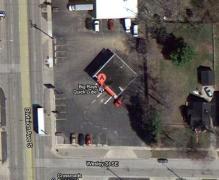
|

Left click on the image below for a larger version.
Bill's Appliance, operated by Bill Homminga, father of Jerry Homminga, class of 1964, was an example of the kind of family owned business along Division Avenue in the 1960's yet. People both known to, and living in, the community.
It took a great deal of product knowledge to handle trade ins as well as service products. In those times products could still be serviced. The battery charger and tester that Bill Homminga holds dates from a time before sealed batteries, when a battery might still need to be topped off with water now and then because of an improperly operating voltage regulator. The business might also have a tube tester, which could be used on the radios and TV's of the time.
Alas, most of the family owned businesses along Division Avenue succumbed to chain stores, and the march of technology, which made products cheaper, more reliable, and almost impossible to fix.

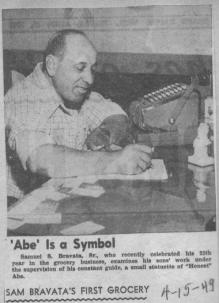
|
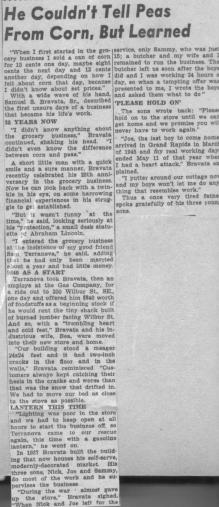
|
Left click on the images for larger versions.
Located at 200 Wilbur Street SE, on the southeast corner of Wilbur Street and Jefferson Avenue, Bravata's was a neighborhood store of a kind that barely exists any longer. Family stores enjoyed no economy of scale, and were very demanding of the families that ran them. Built and operated in a day when people still walked, and when most people knew each other, most of the stores were put out of business by chains and supermarkets by the early 1950s already. Reading the piece above shows how very hard people had to work to run a small store - very long hours, and at many different kinds of jobs. Something like a small family owned restaurant today, that must be open 16 hours or so each day, and endure long slow periods throughout the day when customers are scarce, but expect it to be open whenever they decide to visit.
But in it's early days Bravata's must have been a real convenient place to shop for people that lived around Godwin. The fate of Bravata's is unclear at this time.

Left click on either image for a much larger version.

|
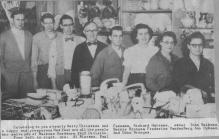
|
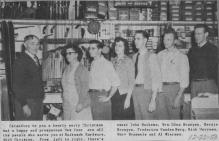
|
Material supplied by Lillian Annis, class of 1941
The strip mall consisting of Lamoreaux's, Buikema Hardware, the 5&10 store, Foster's Market, and a bakery, carried just about everything a community needed in the way of home supplies. Local businesses for decades, they were staffed by people who lived in the community, and often made careers of working in the stores. In one way or another, all have succumbed to the relentless pressure of modern chain stores, which in some ways have little stake in any particular community, but far lower prices and a greater variety than family run stores could ever provide. And few pay enough to attract anything other than short term help.
Left click on the item below for a much larger version.
The item above, supplied for scanning by LeRoy Rockwell, class of 1959, shows that by 1959 already the concept of a stand alone hardware store was becoming untenable. V&S, apparently representing about 450 hardware stores at the time, was a kind of forerunner to the True Value and other hardware chains of year 2006. Few small hardware stores could afford to publish detailed catalogs, and carry the range of stock, that a chain can. And there is also the need for volume purchasing to keep prices lower. Even so, a scan of the catalog above shows that while wages in 1959 were perhaps 10% to 15% of what they are in year 2006, the prices in 1959 were only about 50% less than in 2006. i.e., things were quite expensive relative to year 2006. In year 2006 the same items are likely to be made of better materials, and provide a much better value. Of course they are also likely to be made in China, or so other low cost country.
John Buikema was on the Godwin school board for many years. See section "B" for more details. As the item on the left, above, suggests, he was already in business for about 20 years when the expansion described occurred. It was likely not always in the same location however. for Al Wiersma graduated from Godwin in 1941, and died in January, 2006.
As of year 2005, Buikema Hardware is but a memory.

Left click on the images below for larger versions.

|

Left click on the image below for a larger version.

Left click on the image below for a larger version.
Chickee Drive In, 3117 South Division, shown in 1952. It's not known when the business or the building disappeared. There seems to be no sign of it in year 2012.

Left click on the image below for a larger version.
The 1953 photograph above shows a Cities Service station located at 3318 South Division Avenue. Cities Service was a major brand in the area at that time. In year 2012 there is no sign of the station or the house next to it at that address.

Left click on the image below for a larger version.
The Clyde Park Food Center is where many went on a Saturday night to pick up chips, pop, etc., for an informal gathering. There is another such store just to the right. The photo above is dated 1955.

Left click on the image below for a larger version.
Chuck Brinks, at 2890 South Division Avenue, was one of many used car lots along Division, between about 28th and 36th, in the 1950s and 1960s. Note the four strings of lightbulbs that made the lot glow like the noon hour sun. In those times MI still had a 50% reserve of electrical capacity, and the power companies encouraged any kind of use of electricity. One can estimate there are 160 lightbulbs showing in the photograph. At 100W each, that's 16KW of power, or about one dollar an hour to runs the lights. In year 2012 a display like that would be seen as environmentally contemptible.
Also note that starting with the base of the sign one sees a T-Bird, perhaps a 1963 Corvette, and perhaps a 1958 Corvette. One also does not see huge fences, topped with razor wire, encircling the lot.
In year 2012 there is no sign of Chuck Brinks.

Left click on the image below for a larger version.
Dairy Treat, shown in 1964, was known for it's flavored soft ice cream. For the most part, Dairy Queen offered just vanilla. Dairy Treat would have a flavor of the week, which might be lime, banana, or dark cherry. In year 2012 the building is gone. How much before that is unknown.

|
|
|
||||
|
|
|
|
The photographs were provided by Lee Smith, Godwin class of 1953.
Sandwiched in by a Subway on the left, a KFC about two doors down to the right, and families that don't much eat out as families any more, there doesn't appear to much room for the locally owned family businesses that thrived along Division Avenue, just north and south of Godwin school, any longer.
The overpass walkway across Division Avenue, shown in a photograph above, replaced the tunnel, built in 1937, some time in the 1970s. A changing area made it too dangerous to use the tunnel any longer.
Dating back to at least 1963, as shown in the photo below, the sign originally showed "Steaks, Chops, Dinner."
A 1963 photograph. Left click on the image for a larger version.
Once another Godwin hangout during school hours, and a place within walking distance for other local business and families to catch a meal, the area around Godwin doesn't support this kind of restaurant any more. No area does much today. One can imagine that a lack of parking of the kind found in strip malls, and a public preference for familiar chains, simply meant that time passed Dick's Fine Foods by.
Left click on any image for a larger version.
Material provided by Bob Traetz, class of 1962.
The Dick's Galley menu above probably dates from the early 1960s.
Toast and coffee for 25 cents is not something one often sees in the US in
year 2006.
Material provided by LeRoy Rockwell, class of 1959.

|
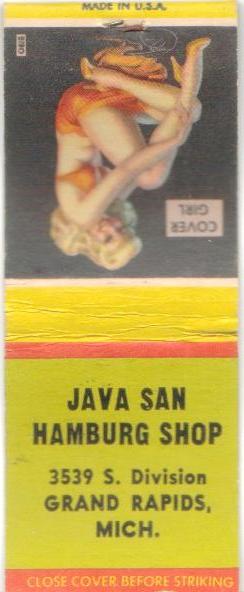
|
Material provided by LeRoy Rockwell, class of 1959
The Java San Hamburg Shop has the same address as Dick's Galley. Just when it operated at that location is not known at present.

Left click on the images below for larger versions.
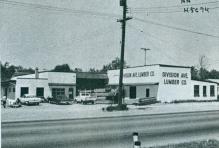
|
Division Avenue Lumber Company, 1966. Located at 3501 Division Avenue, just north of Bertrand's. Just when it moved or went out of business is unknown here.

Left click on the images below for larger versions.

|
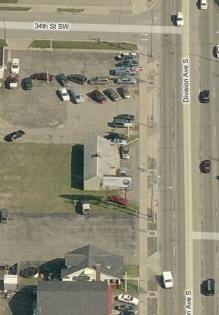
3425 S. Division, in 2012. |

Left click on the images below for larger versions.

|

247 32nd St. |
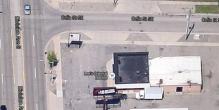
3004 Division in 2013. |

Earl Robson came to Michigan from Ohio in the early 1920s to escape hay fever. He was active for years in the development of the Home Acres area. Plans for development along Division Avenue were apparently that the pattern of Burton Heights would be repeated every couple of miles to the south. Starter buildings were placed along the way. One is/was just south of 32nd Street, on the west side of Division Avenue, and another on the same side a block or two south of 40th Street. A business building, with an apartment on the second floor, and a business on the first floor, it was intended that other buildings would abut the starter buildings, and start another strip of buildings, much like Burton Heights, and later by Lamoreaux's drug store, and then Home Acres. Neither the one near 32nd nor 40th Street ever developed. It's possible the Southlawn Theater was an attempt to duplicate the Four Star Theater. There might have been another theater past 44th Street, in Home Acres, before 1950.
Earl Robson was an early booster of the Home Acres area, which started to grow when the Picric Acid Plant was being constructed in Wyoming in the period from about 1916 to 1918. Just what was envisioned is not clear, but the area seemed to have stabilized by about 1950, or maybe before. Robson's was a fixture of the area for many decades, but, as the piece below suggests, fell victim to the mass merchandising movement that started in the early 1960s. The more personalized service offered by community stores like Robson's could not compete with the lower prices offered by no frills clothing and department store chains.
Earl Robson knew many of those interested in real estate development along Division Avenue in the late 1920s and the 1930s. Apparently he led area hikes in his later years, and was still doing so into the 1970s.
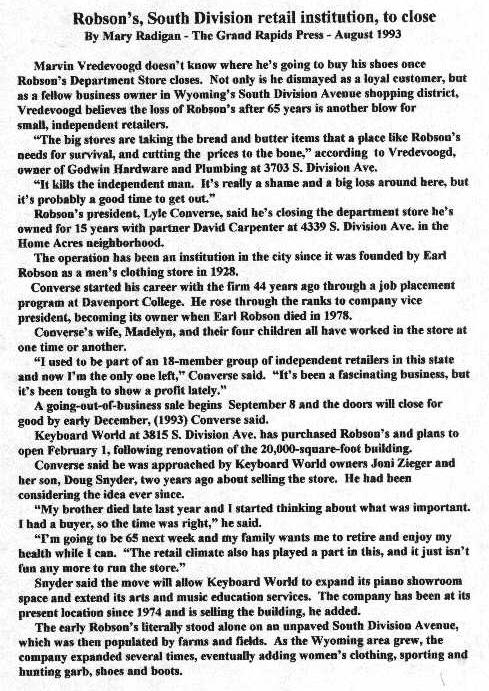

Material supplied by Lee (Tanner) Collins, class of 1941.

Left click on the images below for larger versions.

|
Above, Emdin's in 1972.

Left click on the images below for larger versions.

|

|

Left click on the images below for larger versions.

|
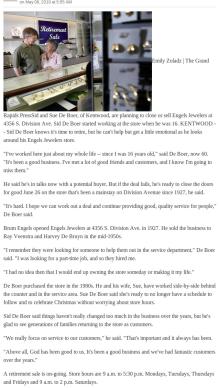
|

Left click on the images below for larger versions.

Circa 1968. |
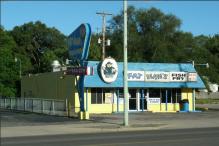
|
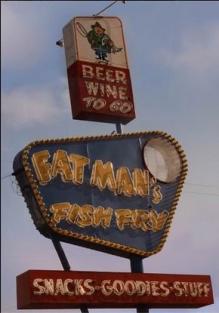
|


Left click on the images below for larger versions.

|

|

Left click on the images below for larger versions.

|
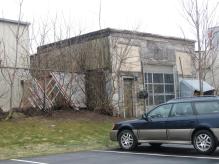
|

Left click on the images below for larger versions.
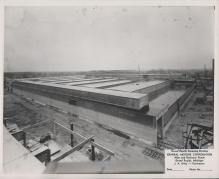
1935 |
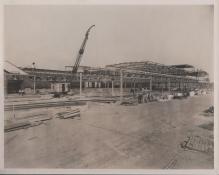
1935 |

|
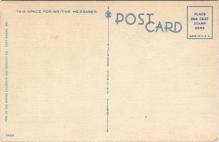
|
The land was once leased by the Zandstra family. Below is a photo of the family and the family farm house in 1910.
Left click on the image below for a larger version.
Pictured from left to right are Carnelius (Son), Anna (Grandmother), George (Father) and Dora (Daughter) Zandstra.
The 77 acres of land was apparently owned by the Hanchett family. When it was obtained by GM, and the early story of the GM plant, is given in the piece below.
Left click on the image below for a larger version.
As was almost always the case, the plant was an environmental disaster for the area. The stream running along the Pennsylvania ( previously the GR and IN ) Railroad track was remembered to be a trout stream before the GM plant located in the area. A large swampy area existed to the east of the railroad tracks and south of 36th Street, and was the origin of the stream. The swamp was filled in, and industrial sludge was dumped in to the stream, turning it in to an open sewer line.
The plant was a boon to the Godwin Heights area, providing stable tax revenue. The Great Depression was in full swing yet in 1936, and while car sales were likely not brisk, the fact GM built the plant suggests there was business, and the help to the surrounding community in terms of jobs and tax revenue must have seemed like a miracle. In the late 1960s and the 1970s tax revenues made the area so flush that Godwin hardly knew how to spend all of its funding. Salaries, pensions, and perks were no doubt lavish.
In year 2008 both the area and GM have seen reverses. Reverses that have nothing in common save that the Godwin Heights area can probably look to less tax revenue in the future.Left click on the image below for a larger version.
Just about exactly 76 years ago, on December 20, 1935, the Grand Rapids Press carried an article about the new GM stamping plant on Allen Road ( now 36th Street ) and Buchanan Avenue. In an article on about December 20, 2011, above, a talk is mentioned about the history of the plant, which has now long since ceased operations. A sad commentary on the might of US industry in the past, the GM stamping plant made the Godwin of the 1940s through roughly year 2000 a school that was flush with funding. With a budgets of something like $24 million in year 2011, and the large staffing costs of a modern US school, only state tax money will likely be able to keep Godwin afloat for a lot longer.
Left click on the images below for larger versions.

Summer - 2011. |

Summer, 2012. |
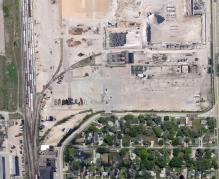
Summer, 2012. |

Summer, 2013. |
The satellite image above shows the GM stamping plant on the southwest corner of Buchanan and 36th Street in year 2011. As of spring, 2012, the plant has been largely razed. At some point aerial views of the site will be found. It now remains to be seen what, if anything, is done with the land. Alas, given the railroad track on the west side of the property, as well as US 131 to the west of that, the land would seem ideal for some kind of manufacturing plant, a warehouse, or perhaps something like a Wal-Mart. Given the costs of doing business in Michigan in year 2012, a manufacturing plant seems doubtful - if it made any sense the GM facility would presumably not have been shut down and razed.
Left click on the images below for larger versions.
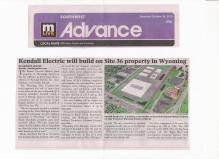
|

The Godwin Coffee Cup restaurant, earlier known as the Godwin Coffee Shop, was located at 3614 Division Avenue, approximately just south of Enamelite, the business that Charles Saur started after he retired from Godwin in 1950. The Coffee Cup existed at least in the 1940s and early 1950s, and was a favorite hangout for Godwin students, who would eat their lunch there. The owner was Henry K. Carpenter ( father of Edna (Carpenter) Keyes, class of 1934 ), who was also the chief engineer at Godwin.
Photographs of the inside of establishments are not common. The one of the Coffee Cup restaurant, below, might show Henry Carpenter, the owner, and his wife.
Left click on the image for a larger image.
The photograph was made available by Leon Smith, class of 1953
The Coffee Cup restaurant was typical of many restaurants along Division Avenue, and a few on 36th Street, across from the General Motors stamping plants in the 1930s through the 1950s, and perhaps somewhat before and after that. Plain and functional would describe most of them. Rectangular buildings, plaster walls and ceiling (swirl patterns in the ceiling plaster can be seen in the photograph), fluorescent lighting, a counter, and square tables and wooden chairs. The heater was often as not a gas or electric unit hanging from the ceiling, as can be seen on the back wall in the photograph. Called a space heater, this arrangement is only used today in large commercial buildings.
Somewhat more civilized behavior made it possible to have things like paper napkin dispensers on the tables as well as salt and pepper "shakers" and sugar containers. The massive amounts of paper and plastic generated today to serve a meal in a restaurant was mostly not necessary - the clientele largely knew one another and likely as not the owners. And there would have been a waitress or two, often Godwin students. Jalene Doxtator, class of 1947, was one. She mentioned that Frank Rackett would come in every night for dinner, and the owners would tell her to just give him whatever he wanted. It was that kind of world then, and that kind of community. Wilbert Beattie, South HS class of 1945, also worked there for a while before enlisting during WWII. Later, he and Jalene Doxtator would marry. Jalene also mentioned that the food was great, and the malteds and milkshakes were the best around, likely reflecting the use of real ingredients. The owners would likely have been operating and working at the restaurant for a long time, and probably were the parents of Godwin students. The restaurants were inevitably locally owned and operated, and it was commong for those in the surrounding neighborhood to eat at places like the Coffee Cup frequently, in part supporting the sense of community. After 1936, many of the little restaurants in the area would also benefit from the growing number of people employed at the GM plant.
The menu, shown below, from about 1943, shows that the war effort did not affect the eating habits of those on the home front much. While there were shortages of many things during WWII, food was not one of them. And one has to do some mental gymnastics to go from the prices of 1943 to 2005, where everything on the menu would cost 10 to 15 times as much.
|
|
|
||
|
|
|
The menu was provided by Norrine (Chase) Polkowski, class of 1946.
Many of the restaurants catered to workers at local businesses and factories. The food varied from bad to what would be described as good home cooking. As in the 21st century, deep fried was almost guaranteed to be on the menu, and many a hamburger, frenchfries, and a Coke or Pepsi slid down at lunch. Becoming a hangout for Godwin students guaranteed a lunch crowd. At night local families ate at the restaurants for a more relaxed night getting out of the house for a change.
Specials of the day offered patrons a volume meal at a lower price, and helped take the burden off the cook, who, to a large extent, had to make everything from "scratch." Frozen, prepackaged, microwave, and other modern labor saving cooking words either didn't exist yet, or were not common. After the rush hour died away the staff could take a load off for a while over a meal themselves.
And have a cup of coffee. "Fast" was not yet part of the eating vocabulary, and people socialized over a stationary meal rather than eating as they walked or drove around. After killing enough time, patrons would pay up, and grab a toothpick on the way out.
Left click on the image below for a larger version.
By 1948 the range of offerings and services was quite extensive, including catering and take out.
In August, 2007, Starr Kent, class of 1956, pointed out that in 1954 and 1955 Gert and Tony Dornbush owned and operated the Coffee Cup restaurant. "Their daughter Eline (Penny ) worked there, and during lunch hours Elaine, Christie, Penny and I (Starr Kent ) worked there to get our lunch free. They waited tables and I washed dishes."
Left click on the image below for a larger version.
The Godwin Coffee Cup building at 3614 South Division still exists in year 2012 as The A. Dong Market, but like so many other familiar landmarks from the 1940s and 1950s, an altered external appearance removes any resemblance to former establishments.

Left click on the images below for larger versions.
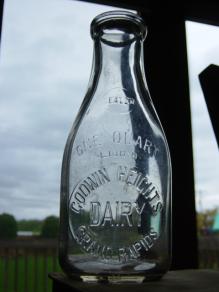
|

|

|
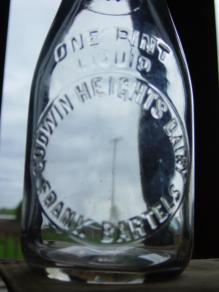
|

|

|


Material supplied by LeRoy Rockwell, class of 1959.
Godwin Heights Plumbing Co. was located at 3647 Division Avenue, and was in business in 1933 already. It is not clear that there is any relationship to the current Godwin Plumbing, which formed in 1955. Or whether Godwin Heights Plumbing still exists, and if not, what happened to it.


Left click on the images below for larger versions.
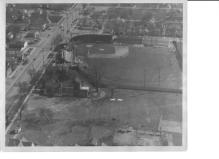
|

Detail of Herzog Roadhouse. |

|

Left click on the image below for a larger version.
The photograph above is dated 1950. The Hi-Lo Dairy was located at 3449 South Division. In year 2012 there is no sign of the building.

Similar to Burton Heights and Godwin Heights, Home Acres was another commercial development area, probably started in the 1920s when Earl Robeson came to the Grand Rapids area from northern Ohio to escape hayfever. He and three or four other local businessmen decided to establish shops in the area of Division Avenue and 44th Street. This repeated a pattern going south along Division Avenue from Grand Rapids, where commercial areas were established every mile or so. Starter buildings, a store with living quarters on the second floor for a small family business of some kind, were intended to be the nucleus of another row of stores, which would butt up against each other, and result in something like the Burton or Godwin Heights of the 1940s and later. Most did not take, and even in to the 1960s one would still see the lone starter buildings along Division, out to about 42nd Street. Those that did were usually the focus of shopping for local neighborhoods.
The scheme was complicated by the Division Avenue Bus Line, which gave
those same neighborhoods access to Grand Rapids, which then competed with
local clothing and other kinds of stores. But well in to the 1950s areas
like Home Acres were relatively isolated, well defined shopping areas,
similar to the strip malls of year 2007, and were well supported by the
surrounding communities.
Left click on the images below for larger versions.

|

|
Material provided by LeRoy Rockwell, class of 1959, and Steve Bloye, class of 1960.
The photograph above, left, shows Home Acres in 1936, about 9 years after it was built. Just to the right of the truck with Kendall oil on the side, notice the A&P store. Very tiny for a grocery store by year 2009 standards, they were ubiquitous in the 1930s, typically family owned, and convenient for people on foot. Prices and a lack of selection were their undoing in later years. For reasons unclear, A&P did not successfully make the transition to today's supermarket. Engle's Jewelry store was in the same location in 1936 as it is today in 2009. Shippy's drugstore is long gone however, as is the bank that was in the building next to 44th Street.
The postcard image above, right, has poor definition, and most details are not clear, but it does give some impression of what Home Acres looked like in about 1955, as seen from Division Avenue and 44th Street. Engels jewelry store is probably the only business which has been in continuous operation from the start of the development of the area. The Division Avenue bus would have been a familiar sight, and was still a very popular way for Godwin students to get around the area, including in to downtown Grand Rapids.
By the 1960s development along Division Avenue was so complete that the notion of individual shopping areas had largely blurred. In year 2007 areas like Home Acres have little individual meaning, and areas like Burton Heights have significantly deteriorated. It is hard to image how lively these areas could be during Christmas in the early 1950s yet. The Southlawn shopping area does not have meaning for most people in year 2007. A placard still denotes the Southlawn area, and there is a Southlawn church, but other businesses like the Southlawn theater and barber shop are at most memories today.

Left click on the image below for a larger version.

Left click on the image below for a larger version.
The photograph above dates from 1954. A institution for perhaps 25 to 30 years, the Home Acres Feed Store was something of a farm store, selling seeds, cracked corn, cat and dog food, etc., in bulk, and in bins with self-serve scoops. It was the place people who operated bird feeders might go for sunflower seeds and other items. It's not clear why or when it went out of business. Buying the same materials in small packages at a grocery store is vastly more expensive.

Left click on the images below for larger versions.
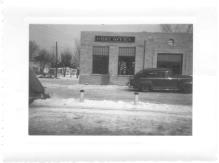
|

|
Home Acres Post Office - left, February 4, 1948, right, 2012. What the building is used for in year 2012 is unclear just now. The street on the right is Murray.

Left click on the image below for a larger version.
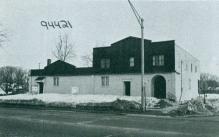
|

Left click on the image below for a larger version.
The photo above is from the early 1950s. One senses that winters were more severe then. While one can hardly see the cars, which no doubt had a negative impact on sales, one can otherwise see what a typical 1950s used car lot along Division Avenue looked like. There were the strings of endless lights, which made Division Avenue between about 28th and 44th Streets a very bright place at night.
While surely not every dealer engaged in such practices, terms like "bondo" described attempts to patch "body cancer," the phrase used to describe the fact that in the 1950s US cars were rusting away essentially as they were driven brand new from the dealership. On top of the bondo, which was little more than a plastic, a little crude spray painting would often be done. Savvy customers might come in with a magnet and, in addition to a simple visual inspection, determine where all the rust holes had been filled, and, from the dealer's point of view, hopefully camouflaged well enough to get the vehicle sold. In any case, bondo did not last very long, and in little time the cars holes would appear again.
Other tricks were employed to try to mask the fact that a car might use a lot of oil, which cars did anyway in the 1950s, when 500 miles to a quart was considered good. But a real oil burner would leave the air on a street blue, and smelling foul, as it passed. Before the days of any environmental laws, a car would have to burn truly outrageous amounts of oil before an owner would be arrested. The use of oil was largely an economic concern to most people. So a dealer might put especially heavy oil in the crankcase.
A potential buyer might have the option of having a mechanic check out a car before buying, but in general a game was played between the customer and a dealer, in which the dealer tried to get as much money for a car, irrespective of condition, and the customer, who knew a car was likely not all it seemed. Warranties were rare on used cars in the 1950s, and if offered at all probably meant the car would be much more expensive. It should be remembered that when selling a car, or trading one in for a newer one, owners now became dealers in a sense, and would likely attempt to employ all the same deceptions, In a very real way, most people knew the used car game from the vantage points of both buyer and seller.
All of these practices reflected the fact that the US auto industry had a de facto monopoly on car production, and with that lack of competition came basically shoddy products, which were poorly assembled, rusted quickly, and cost buyers a lot of money for maintenance. This situation would last until the Japanese auto companies got a strong foothold in the US market in the early and mid 1960s, and sold cars with an emphasis on quality. In year 2006 US auto companies have still failed to get on board with customer expectations for better quality cars, and lose more market share every year.
One sees fewer "as is" kinds of used car lots in year 2006. Even the name has often been changed to more euphemistic sounding phrases like "pre owned." Many low mileage used Japanese cars command a high fraction of their original cost, and usually come with some kind of warranty.

Left click on the images below for larger versions.
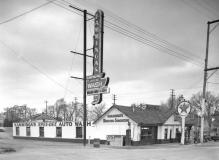
1949 |
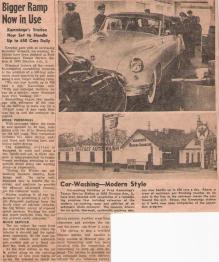
c1950 |

|
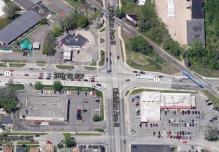
2014 |
The newspaper piece, above, right, provided for scanning by LeRoy Rockwell, class of 1959.

Left click on the images below for larger versions.
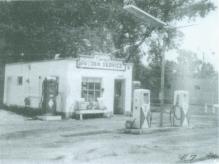
|
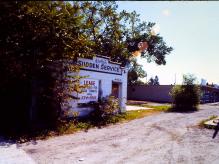
|

|
It was "Dewey's Sudden Service" owned by Dewey Shackleford. He had a pot bellied stove that a lot of the Godwin kids use to stand around and talk to Dewey. Also remember at that time it was five gallons of gas for one dollar. The station had one main office, a small annex at the back for oil and other supplies also an outside oil change pit. Dewey always wore a black colored winter type coat with sheepskin lining during the cold weather. Think it was a favorite of his. He was originally from down south, believe it was Arkansas. Maybe that's why he needed the big coat.
In between customers, Dewey use to construct coffee tables with ceramic tile tops in the station. His wife was a very good artist.
As I recall, they incorporated the old building into an ice cream stand. Dewey was always a true friend of the Godwin group.
Shortly before Dewey retired, I took a photograph of the station and presented it to him, don't know what ever happened to the negative, etc.
Dewey got quite ill later in life and my dad use to take him to the various doctor's, etc. I don't believe his wife drove. They use to live on Canterbury Street west off Division. Their home was on the south side of the street about the second house west of the restaurant on Division. He died probably 25 years ago, after that, think his wife moved to the Detroit area where she had relatives.

Left click on the images below for larger versions.
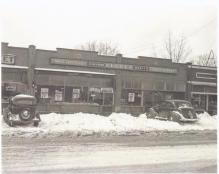
|
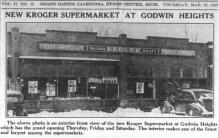
|

Left click on the image below for a larger version.
A door on 36th Street, adjoining the barbershop and hair salon on the west side of the drugstore, was used until the late 1950's. Hard to monitor from the rest of the store, perhaps sticky fingers were common enough at the time to lead to big losses of merchandise.Left click on the image below for a larger version.
December 23, 1957.
Left click on the image below for a larger version.
1972.
Just when Lamoreaux's became Wonderland Pharmacy is not known here. Boyd Lamoreaux died in Grand Rapids on June 3, 1993. As of year 2011 the drugstore is but a memory, and the building is now occupied by a vacuum cleaner store.

Left click on the images below for larger versions.
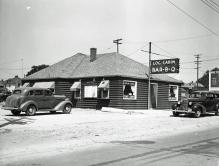
July 12, 1939 |
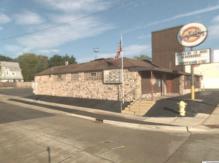
2013 |
The Log cabin, at 2401 South Division, in July, 1939. It still exists in year 2013, with greatly altered appearance.

Left click on the images below for larger versions.

May 17, 1944 |

December, 1961 |
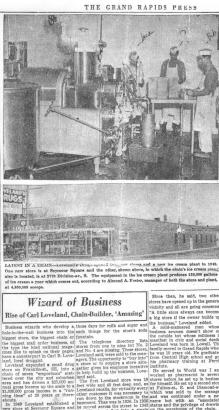
1950 |

2014 |
Loveland's Drugs was located at 3770 Division Avenue. In the photograph above the store was perhaps a year old. It was managed by Almond A. Foster, Godwin class of 1929, who had already managed another drug store on Wealthy Street. In addition to the ice cream factory in the back, there was a soda fountain on the south wall of the building, just to the right as one entered the store, where one could indulge in some of the same ice cream. Many Godwin students remember working in the store in the 1950s. Shown at the top of the newspaper piece are Bob Foster, at the right, class of 1946, and Jack Foster, at the left, class of 1940. The other person is unidentified. Clayton Graves, class of 1948, and Karl Vander Laan are two other Godwin students who worked at Loveland's
Loveland described his later stores as "emporiums," which later might have been called a variety store. In some ways this was a common trend in what were earlier called drug stores, which combined prescription sales with a soda fountains. Loveland expanded the notion still further, in that comic books, cards, toys, candy, and many other items were sold. In many ways the lines were blurring between the older notion of drug stores and variety stores, which often appeared in an area together. This trend is still evolving. But, alas, it's rare indeed to see a drug store with a soda fountain any longer.
While the building still exists in year 2005, it has not been a drug store for some time. As the piece mentions, at one time there were nine Loveland's Drug stores. Another was located in Burton Heights, on the northeast corner of Burton Street SE and Division Avenue. Whether there are any in year 2005 is unclear. With luck, Loveland might have been able to expanded his chain still further. It is not known here why he stopped at nine. But in general almost all locally owned drug stores have gone out of business. It's simply impossible to compete with the national chains, with their vast purchasing power, and in year 2005 one sees many drugs stores in the area, but none with the personal touch of those in the 1950s and before. The primary function, filling prescriptions, is a fabulously lucrative business in year 2005, a highly technical one, and one that requires very expensive inventories. The national chains can be open 24 hours a day, which would be barely possible for a small chain of 5 to 10 stores.

Left click on the images below for larger versions.

|

|

|
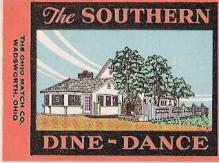
|
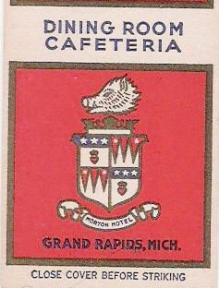
|
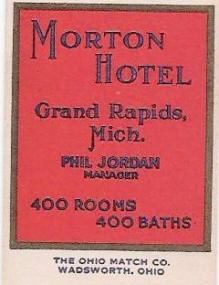
|

|
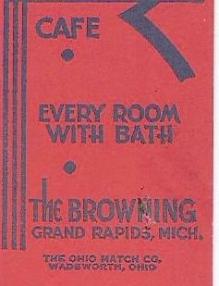
|

|
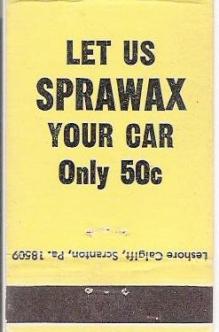
|
LeRoy Rockwell, class of 1959, provided the match books for scanning.


Left click on the image for a larger image.
Material supplied by Lillian Annis, class of 1941.
Typical of a family run store of the early 1950s and before, and located across the street from Earl Robson's, they are mostly but memories today. In their day, employees might work at a store like Mieras Dry Goods & Shoe Store for decades.
Family owned businesses were a hallmark of the tight knit communities of 50 and more years ago ( from year 2005). But as people became more mobile, and neighbors started to become strangers, people began to prefer the more impersonal atmosphere of the large chain store. And of course the cheaper prices and larger selections. In the day of the family run dry goods store, people tended to only have a few shirts, pants, socks, shoes, etc., and even fixed them when holes began to appear. In year 2005 most people have closets full of these articles, mostly made off shore, and when a thread appears the article gets tossed.
Like so many family run businesses in the Godwin Heights, Home Acres, and Burton Heights areas, Mieras is now but a memory.

Left click on the images below for larger versions.

|

|

Building at left, in 2013. |


Left click on the image below for a larger version.
The photo above is from a Christmas edition of the Photo Reporter from about 1959. In year 2012 Robert Morris is about 90, and remembers wiring many buildings in the Godwin area, including parts of Bigelow Field.

James Westra operated "Jungle Jim's Pet Store," on Division Avenue, for many decades. It was originally located on the east side of Division Avenue, at about 41st Street, and started business in about 1955. People there were very tolerant of students coming in just to look, using the business as something of a local zoo. A personal fantasy was to own a small alligator, which at the time was about six dollars. Sometime later the business moved to 3815 Division Avenue.
Many of the animals sold, bought largely as curiosities, probably did
not meet a good end. Because of habitat loss, and a pet trade that leaves
many animals dead during the process of capture and transport, many of the
animals sold during the 1950s and 1960s are now very rare, and in some
cases almost extinct. People that bought many of the animals lost
interest in them, usually meaning the animal was doomed. So while a
amusing phenomena for many years, pet shops like the one James Westra
operated cannot exist today, except for those animals that can be
successfully bred for this kind of commerce.
Left click on the images below for larger versions.
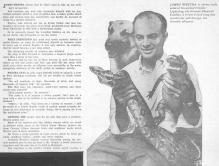
|

|
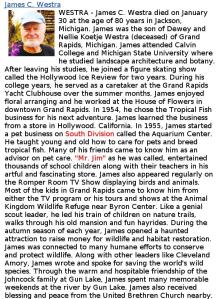
|

|

Left click on the image below for a larger version.
The image above is from a scrapbook assembled by a person in the class of 1929 - the person did not graduate. So the Octagon Restaurant might have been built as early as 1929, or before. The Home Acres strip, on the east side of Division, starting with the bank on the corner of Division and 44th Street, was built in 1927.

Left click on the images below for larger versions.
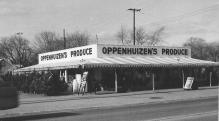
|

Left click on the images below for larger versions.

|

|
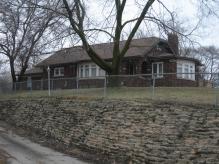
|

Left click on the images below for larger versions.
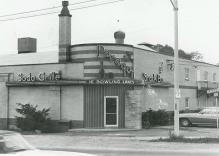
|
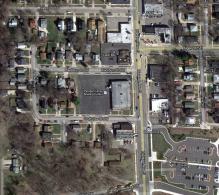
|

Left click on the images below for larger versions.

1947 |
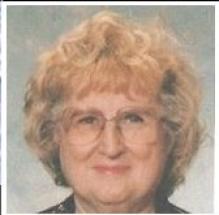
2013 |

Left click on the images below for larger versions.

|

Left click on the images below for larger versions.
The Root Beer Wagon, at 2907 Division Avenue, operated until about 1953, after which it became a used car lot. A stereotypical 1940s drive-in, it was built by Della and Paul Wicks, and managed by an employee, who was allowed to choose the name of the business. In the beginning it was the B&K Drive-in. Like most businesses along Division Avenue in the Godwin vicinity, it would have employed Godwin students.
The the lawn and flowers in the front of the building were typical of businesses along Division Avenue in the 1940s and earlier, and probably suggested a more family oriented set of businesses.

The branch located in Grandville was perhaps a little off the beaten track for Godwin students in general, but might well have been an eating spot for those retuning from Grand Haven. The original location in Holland is now about 70 years old.
In year 2006 the Russ' in Grandville looks nothing like the drive-in style shown above. It is now largely an indoor eating establishment.

Left click on the images below for larger versions.

|

|
Material provided for scanning by LeRoy Rockwell, class of 1959.

Left click on the image below for a larger version.

Located at 4157 Division Avenue, the Southern Barbecue restaurant went by a few name variations. In 1950 it was simply called the Southern. Perhaps in the 1930s, a number of cabins were built along Division Avenue, north of the restaurant, and a few efficiency cabins along Thurston Street, which provided for long term stays. The efficiency cabin nearest the restaurant was occupied by Herb and Ester Keyser, who managed the Southern in the late 1940s and early 1950s. Built around a farm house at the location, the restaurant conveniently burned down at one point, and the cabins were razed. Today the site is the location of a Bran's restaurant.
Left click on the image below for a much larger version.
Material provided by LeRoy Rockwell, class of 1959.
Left click on the image below for a much larger version.
Material provided by LeRoy Rockwell, class of 1959.
The items below are from the early 1930s. The one at the top, left, is dated April 21, 1934, and is a list of restaurant regulars. Perhaps some of the people are current or former Godwin students. The note at the top of the item points out that patrons should not try to sneak liquor on to the premises. But wine and beer were sold, so perhaps the Southern Barbecue was a tavern that served food.
It's noteworthy that the Southern Barbecue served a number of seafood items. Except for the rich and wonderful, seafood was not widely known by Americans in 1934. People in the Northeast knew lobster very well, but more generally, until the advent of refrigerated railroad cars and trucks, seafood did not normally penetrate very far inland until after WWII. In year 2006, farm raised shrimp are almost commonplace.
Another item of interest is "frog." Likely meaning frog legs, or the meat from them. Just where the frogs came from is not clear. In 1934 yet local ponds and lakes were probably still clean enough to enable frogs to be taken locally, but this would be problematic in year 2006.
An earlier phone number was 8-5154.
Left click on any image for a larger version.
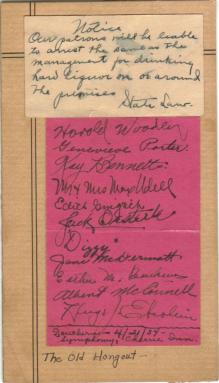
|
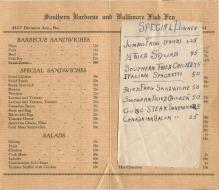
|
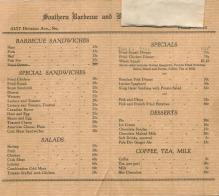
|
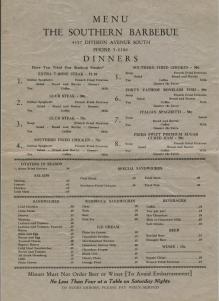
|
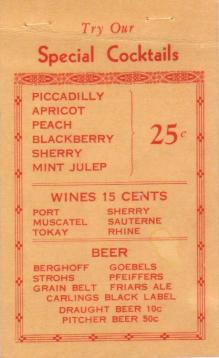
|
Material provided for scanning by John Kamstra, a local collector.


|
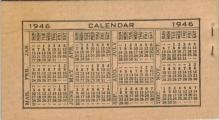
|
Material made available for scanning by LeRoy Rockwell, class of 1959.
The item above is from 1946.Left click on any image below for a much larger image.
|
|
|
||
|
|
|
Material provided for scanning by John Kamstra, a local collector.
Left click on the images below for larger versions.

|
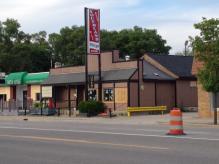
|

Left click on the images below for larger versions.
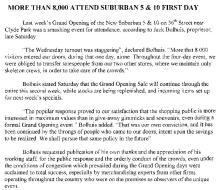
|

|
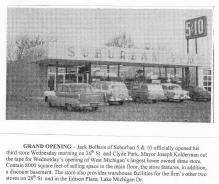
|
Left click on either image for a much larger version.
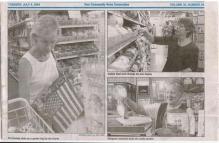
|
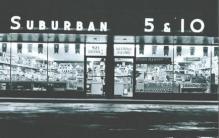
|
Below is the Suburban 5 & 10 as it appeared on September 25, 2004.
Left click on either image for a much larger version.
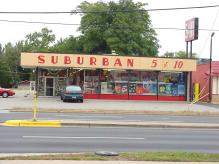
|
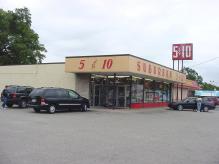
|

Left click on the images below for larger versions.

1953 |
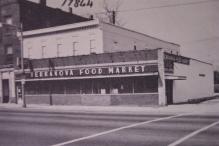
c1960 |
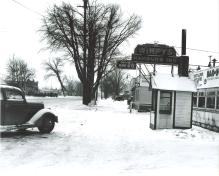
c1940 |

Left click on the images below for larger versions.
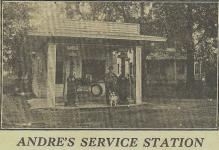
1929 or before. |
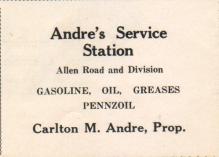
|
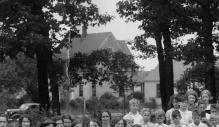
1938 |
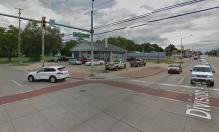
Timmer's -September, 2016 |

Left click on the image below for a larger version.
Image provided by Lee (Tanner) Collins, class of 1941.
The photograph above is of Lee (Tanner) Collins, class of 1941, entering the Five Star Restaurant. The photograph was taken by Roswel "Stubby" Leatherman, class of 1941. The Five Star Grill, shown above in a 1940 or 1941 photograph, is clearly the same building, and just possibly started out as an abandoned Grand Rapids Trolley car.
Note the "Nehi" sign just above and the right of the door handle. Apparently Nehi, a take off on "knee-high," and introduced in 1924, was a very popular brand of soft drink in the 1940s yet. A popular combination would have been a "Nehi and a Coney Island," a.k.a. a soft drink and a hotdog. In 1959 Nehi changed its name to Royal Crown Cola, following a 30 year old court fight with Coke for the right to use the name "Cola." In year 2007 Nehi is a name one mostly sees in old movies.

The image above is from page 6 of the 1946 annual.
The building to the left, on the west side of Division
Avenue, was Baker's Lunch in 1946. It was just south
of where Wexford Street intersects Division Avenue -
3565 Division. In 1950 or so it became Hogan's Diner.
In 1946 it was owned by the father of Donna Baker-Berkey,
who bought the diner from a private owner, and named it Baker's Lunch.
Left click on the image below for a larger version.
Photograph provided for scanning by Phyllis Morris, class of 1962.
The photograph above shows the building as Baker's Lunch. The lettering on the side of the building from the time it was the Five Star Grill has been painted over.
From ads in the Godwin annuals, it seems that Tom Hogan owned the diner by 1950, but the time line of the transition from the Five Star Grill to Baker's Lunch to Tom Hogan's to ashes is not completely known as of May, 2012.Hogan's Diner was located at 3565 Division Avenue, on the west side of the street. Operated by the Hogan family, many people in the area, and probably many Godwin students, dined at Hogan's Diner in the 1950s. Like so many area family businesses, Hogan's too disappeared, apparently burning down some time in the 1960's.
Left click on either image below for a larger version.
The object of the photographs above was a heavy snow storm. Probably in the late 1940s, or early 1950s, based on the vintage of the cars. Also show are part of Hogan's Diner, and a building on Frank Rackett's property.


Left click on the image below for a larger version.
The Twin Cabins Tourist Court, was located at 3430 Division Avenue. One can see part of the west end unit, on Freedom ( formerly Liberty) Street, in a photo taken from Division Avenue.
Left click on the image below for a larger version.
The cabins dated from perhaps the 1920s or 1930s, and were built by George Hammel, a contractor, who also operated the cabins with his wife Marge. There were about six twin units. The layout and other inside details are not known at present. Bob McDonald, class of 1943, worked at the Twin Cabins in the early 1940s, keeping the hot water system going. It is not known whether the cabins had individual facilities, or shared facilities, which was common in older tourist cabins, a concept foreign to US travelers today.
For some reason, the builder did not make the leap to a motel structure. In the early days of tourist lodging, the fashion was to use cabins. Individual units. They provided more privacy, but probably required more upkeep too. The Twin Cabins were just that - two units side by side. Since this still had the potential to let noise go from unit to unit, it probably would have been just as well to butt all the units against each other, which provides some construction economy.
The location suggests that Division Avenue was a more lightly traveled road when the cabins were built, and the area generally less noisy. The cabins still stood in October, 1972, or thereabouts. One can see a date on the right edge of the cabin photo above, To what extent they were in use even by this time is unclear at present. Division Avenue has become an ever more busy and noisy road over the years, and few travelers today would likely see the charm in old cabins without air conditioning and a host of other amenities. In year 2006 the house and the cabins are long gone. Just when they were demolished is not known at present.
Bob McDonald, class of 1943, supplied most of the information above, including the photos. Another set of cabins was owned and operated by the Southern Restaurant, on the northwest corner of Thurston Street and Division Avenue. Complete with individual facilities, the units on Thurston Street were suits, complete with kitchen facilities. The units were likely built at different times. Those along Thurston in the 1930s, and those along Division Avenue in the 1940s. They were still operating in the early 1950s, but are also long gone in year 2006.

Left click on any image for a larger version.
Material provided for scanning by John Kamstra, a local collector.

Left click on the image below for a larger version.
Located where a defunct Burger King located existed in year 2010, one can see in the photograph above Swayne's Bar-B-Q, and down the street from that the parking lot of Oppenhuizen's produce store. That would make the street at the street sign, just behind the car in the Oppenhuizen's parking lot, 40th Street in year 2010. It might have been Washington Street. On the east side of Division one can see Terranova's Grocery, at 4020 Division - at the left side of the photograph, with several cars parked in front. In year 2010 it is S-G Foreign Car parts.
What is striking about the area shown in the photograph is the residential character. Division is tree lined, as it still was around Godwin in the 1950s yet. And there are many houses along Division, most of which are gone in year 2010. It was not a terribly busy road at the time.

Left click on the image below for a larger version.
The name suggests this restaurant and Wimpy's hot dogs are related. There were a number of "Wimpy's" along Division,as far back as 1940 or so. The ad above is from a May 15, 1948, edition the Grand Rapids Press.
Just when the Chickee Drive-In disappeared is unknown at present.


Many once familiar business names in the Godwin and surrounding areas are now but memories. Some merged with other businesses, and lost their names. Other lost out to bigger businesses and chains. Examples of this include Loveland's and Lamoreaux's drug stores.
Below are a few examples of some business names once familiar to Godwin students, but now only memories.
Left click on the image below for a larger version.
The Crystal Flash station shown was located on Division Avenue, probably substantially north of Godwin. The age of the cars suggests the photo was taken in the early 1950s. Once a familiar name in the Grand Rapids area, Crystal Flash no longer exists as an independent name. Other gas station names now gone include Clark, and Town Talk.
Mike Bloore, class of 1955, adds the following, about a Crystal Flash station just north of Godwin:
" The Crystal Flash gas station you posted recently was located 4 blocks North of Godwin School on the Northeast corner of Division Avenue and 34th Street, (formerly Berkshire Blvd.) I lived just five houses East of the station at 35-34th Street, in a small brick home that my father, Ralph Bloore, built on 1929. In the late Forties my sister Beverly (Godwin class of 1953) and I would walk the short distance to the station on hot summer days, and each buy a bottle of "Squirt" soft drink for a nickel. We would then hop up on the cooler in front of the station and watch the folks filling their cars as we enjoyed our soft drinks.
Later on (in 1954-55) I bought most of the gas for my first car (a 1949 Ford) at the station. The manager, a nice guy named Duane, used to let us "regulars" run a small "tab" of up to Three dollars if we were a little short of cash - gasoline was five gallons for a dollar at the time so we could go a long ways on the "tab!"
Talk about FOND MEMORIES!! But that's what the website is all about . . . Thanks, Bob!!"
Below is a partial photograph of the Crystal Flash station, from the long
defunct "Photo Reporter," that Mike Bloore
refers to, and the staff, perhaps taken around Christmas, 1955.
Left click on the image below for a larger version.
Material provided by Lillian Annis, class of 1941.
At the time it seemed to be run by Carl Henry and sons. Since when, and for how long, is not known at present. Perhaps this is after Mike Bloore moved from the area.
Left click on the image below for a larger version.
The photograph above of Fred's Trading Post was taken in 1951. Located at 1550 28th Street, the store and building are long gone as of year 2012.
Left click on the image below for a larger version.
The photograph above is dated 1961. The store was located at 859 W. 28th Street. Note the S&H Green Stamps sign above the "DEPT" on the sign. Rogers eventually relocated in a larger building, but eventually family infighting apparently eventually destroyed the business.

